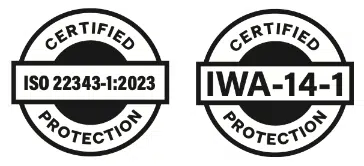All HVM barriers must be crash-tested. This means that they need to undergo testing to ensure they meet specific standards for withstanding a moving vehicle.
Using HVM Measures to Protect Our Cities
Urban designers, landscape architects, engineers, and event organisers are becoming more aware of the security needs in our urban spaces – stressing the importance of implementing measures to protect buildings and citizens from a hostile vehicle attack. As such, hostile vehicle mitigation (HVM) measures are implemented to both assess the risks of an attack and to protect pedestrians. There are generally two main approaches to hostile vehicle mitigation: urban design and physical barriers. Urban design encompasses designing roads or urban spaces to make it more difficult for a vehicle to pick up speed and drive into pedestrians. This will often involve designing curved access roads to the facility or including a sharp turn just before the entrance. A great example of integrated security is the Government Headquarters in Oslo, Norway designed by SLA. Not only does the space make use of physical barriers, but the space is also designed to slow down and mitigate hostile vehicles. On the other hand, when it comes to directly preventing a vehicle attack, physical barriers are the most popular choice for an HVM measure – examples of barriers include bollards, crash fences, and anti-ram gates. These barriers are designed to block vehicles from both entering an urban space, especially if the vehicle is driving at high speeds. An average SUV easily weighs 2,300 kgs, and so a lot of force is exerted if the vehicle is speeding towards a building or pedestrian area. The energy of this force only increases with larger vehicles such as a semi-truck. So, to keep people and buildings safe in these instances, you need a barrier strong enough to stand up to that level of impact and one that can stop a vehicle in its tracks. HVM barriers are typically used in areas where there are a lot of pedestrians, such as shopping streets, concerts, town squares, etc.
It is important to note that hostile vehicle barriers will not necessarily stop someone from planning a hostile vehicle attack. However, when correctly installed and placed, barriers will be able to slow down or entirely stop a hostile vehicle.
How are Hostile Vehicle Mitigation Barriers Tested?
All HVM barriers must be crash-tested. This means that they need to undergo testing to ensure they meet specific standards for withstanding a moving vehicle. The two most relevant criteria to consider in the United Kingdom are the BSI PAS 68 and the IWA 14. The BSI PAS 68, the British Standards Institution (BSI) Publicly Available Specification (PAS) 68, is a key standard for hostile vehicle mitigation products of various kinds and the rating will include information on the type of vehicle and the speed of impact a barrier can withstand. The IWA 14 (International Workshop Agreement) is another important standard, which specifies requirements for a vehicle security barrier’s essential impact performance. This standard is used globally.
The IWA-14 Rating
The IWA 14 is an impact test standard detailing the method and means of measuring the performance outcome for impact tested vehicle security barriers (VSB). Published in 2013, the IWA 14 draws on characteristics from two other major test standards: PAS 68 and ASTM (two of the most common standards you will find for HVM products). Furthermore, the IWA is overseen by the International Organization for Standardization (ISO) and was developed outside the usual committee system. This allows key industry players to negotiate in an open environment, allowing them to shape the IWA standard.
The Numbers Explained

Similar to the PAS 68, the IWA 14 rating starts with the type of test that was conducted — in this case, a vehicle test (V). In other words, a vehicle was crashed into the bollard to certify the product. 7,200 (N2A) represents the type of vehicle used for the test. In this case, the vehicle weight is 7,500 kilograms and the vehicle type is an N2A, a class of vehicle used for testing. 80 is the test speed in kilometres per hour (kph), while 90 is the angle by which the vehicle impacted the HVM product. Usually, this angle is 90°. However, angles of 30° or 40° are sometimes requested when installing products in scenarios with a shallow angle of attack, such as a bridge deck or for testing fences. Finally, 1.9 signifies the impact penetration. This shows how far, in meters, the load-carrying part of the vehicle travelled past the VSB datum line – this is the point from which the vehicle penetration is measured.
Are you interested in knowing more about design-led solutions for your city?
Contact us at: +45 44 97 10 99
Or write to us at: contact@unafor.com






